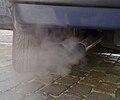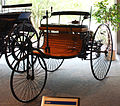Portal:Cars
The Cars PortalA car, or an automobile, is a motor vehicle with wheels. Most definitions of cars state that they run primarily on roads, seat one to eight people, have four wheels, and mainly transport people over cargo. There are around one billion cars in use worldwide. The car is considered an important part of the developed economy. The French inventor Nicolas-Joseph Cugnot built the first steam-powered road vehicle in 1769, while the Swiss inventor François Isaac de Rivaz designed and constructed the first internal combustion-powered automobile in 1808. The modern car—a practical, marketable automobile for everyday use—was invented in 1886, when the German inventor Carl Benz patented his Benz Patent-Motorwagen. Commercial cars became widely available during the 20th century. The 1901 Oldsmobile Curved Dash and the 1908 Ford Model T, both American cars, are widely considered the first mass-produced and mass-affordable cars, respectively. Cars were rapidly adopted in the US, where they replaced horse-drawn carriages. In Europe and other parts of the world, demand for automobiles did not increase until after World War II. In the 21st century, car usage is still increasing rapidly, especially in China, India, and other newly industrialised countries. Cars have controls for driving, parking, passenger comfort, and a variety of lamps. Over the decades, additional features and controls have been added to vehicles, making them progressively more complex. These include rear-reversing cameras, air conditioning, navigation systems, and in-car entertainment. Most cars in use in the early 2020s are propelled by an internal combustion engine, fueled by the combustion of fossil fuels. Electric cars, which were invented early in the history of the car, became commercially available in the 2000s and are predicted to cost less to buy than petrol-driven cars before 2025. The transition from fossil fuel-powered cars to electric cars features prominently in most climate change mitigation scenarios, such as Project Drawdown's 100 actionable solutions for climate change. (Full article...) Entries here consist of Good and Featured articles, which meet a core set of high editorial standards.
Lexus (レクサス, Rekusasu) is the luxury vehicle division of the Japanese automaker Toyota Motor Corporation. The Lexus brand is marketed in more than 90 countries and territories worldwide and is Japan's largest-selling make of premium cars. It has ranked among the 10 largest Japanese global brands in market value. Lexus is headquartered in Nagoya, Japan. Operational centers are located in Brussels, Belgium, and Plano, Texas, United States. Created at around the same time as Japanese rivals Honda and Nissan created their Acura and Infiniti luxury divisions respectively, Lexus originated from a corporate project to develop a new premium sedan, code-named F1, which began in 1983 and culminated in the launch of the Lexus LS in 1989. Subsequently, the division added sedan, coupé, convertible and SUV models. Lexus did not exist as a brand in its home market until 2005, and all vehicles marketed internationally as Lexus from 1989 to 2005 were released in Japan under the Toyota marque and an equivalent model name. In 2005, a hybrid version of the RX crossover debuted and additional hybrid models later joined the division's lineup. Lexus launched its own F marque performance division in 2007 with the debut of the IS F sport sedan, followed by the LFA supercar in 2009. (Full article...) Selected article -Trabant (German: [tʁaˈbant] ) is a series of small cars produced from 1957 until 1991 by former East German car manufacturer VEB Sachsenring Automobilwerke Zwickau. Four models were made: the Trabant 500, Trabant 600, Trabant 601, and the Trabant 1.1. The first model, the 500, was a relatively modern car when it was introduced. It featured detachable duroplast body panels on a galvanised steel unibody chassis, front-wheel drive, a transverse two-stroke engine, and independent suspension. Because this 1950s design remained largely unchanged until the introduction of the last model, the Trabant 1.1 in 1990, the Trabant became symbolic of the former East Germany's stagnant economy and the collapse of the Eastern Bloc in general. Called "a spark plug with a roof", 3,096,999 Trabants were produced. Older models have been sought by collectors in the United States due to their low cost and fewer restrictions on the importation of antique cars. The Trabant also gained a following among car tuning and rallying enthusiasts. (Full article...) Selected picture of the day
Selected biography -Kenichi Yamamoto (山本健一, Yamamoto Kenichi, 16 September 1922 – 20 December 2017) was a Japanese mechanical engineer and business executive. He supervised the development of the Mazda Wankel rotary combustion engine, and served as Mazda's President (1984–1987) and Chairman (1987–1992). (Full article...) On this day November 24Did you know...
Selected quote of the dayIf you can find a better car, buy it! —Lee Iacocca's pitch to buyers of the K-car line that saved Chrysler Corporation from insolvency in the 1980s TopicsGeneral imagesThe following are images from various car-related articles on Wikipedia.
CategoriesThings you can do to help If you wish to help, you can:
Associated WikimediaThe following Wikimedia Foundation sister projects provide more on this subject:
Discover Wikipedia using portals |










































































